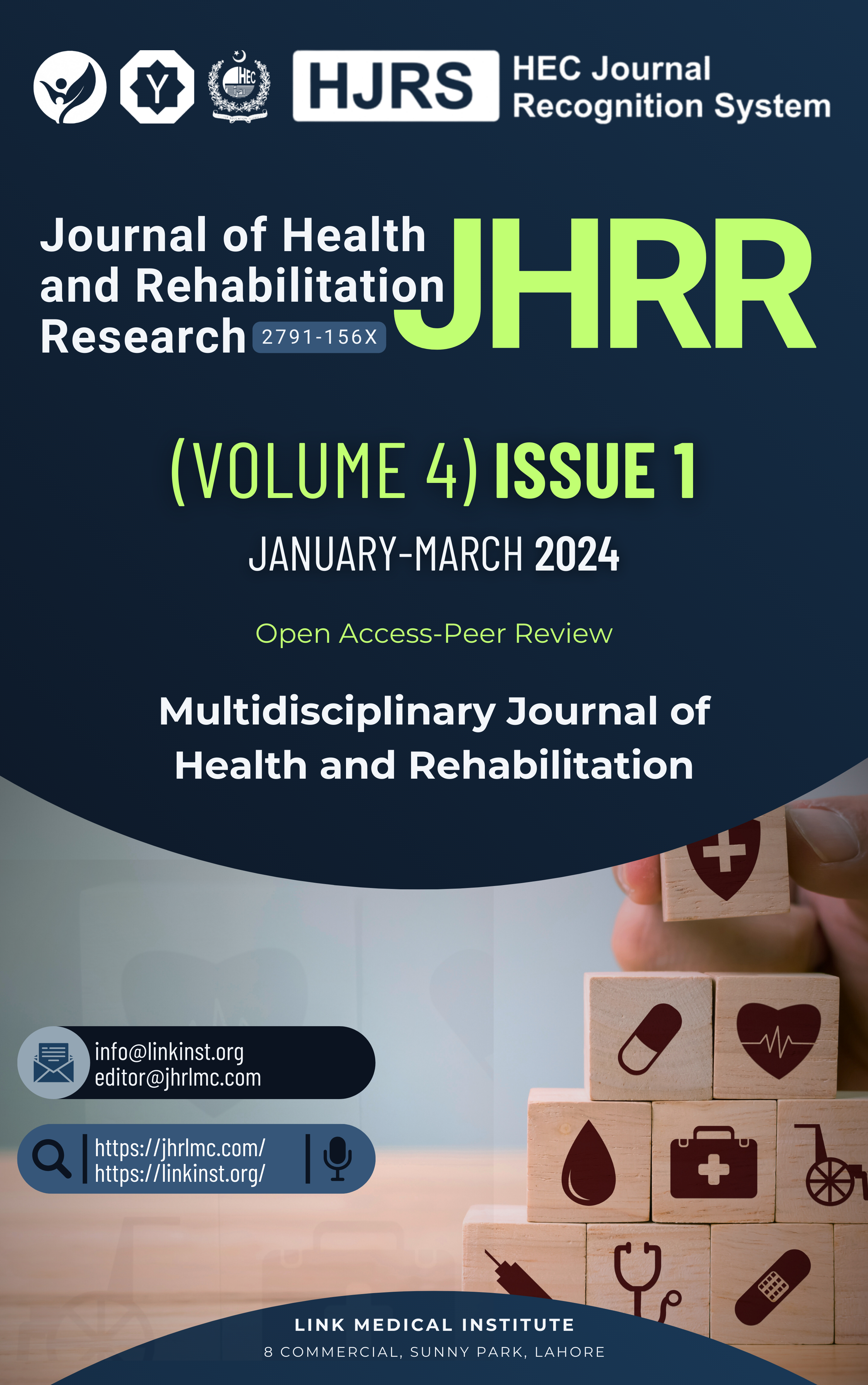Prevalence of Coccydynia Among Wheelchair Users Due to Prolonged Sitting
Coccydynia in Wheelchair Users
DOI:
https://doi.org/10.61919/jhrr.v4i1.370Keywords:
Coccydynia, Wheelchair Users, Prolonged Sitting, Tailbone Pain, Ergonomic Wheelchair DesignAbstract
Background: Coccydynia, characterized by pain around the coccyx, is a common issue among wheelchair users due to prolonged sitting. Despite its impact on quality of life, it remains under-researched in populations with mobility restrictions.
Objective: This study aimed to determine the prevalence of coccydynia among wheelchair users and identify key risk factors such as sitting duration, gender, and cushion use.
Methods: A cross-sectional study was conducted involving 250 wheelchair users aged 15–60 years in South Punjab. Data were collected through a self-structured questionnaire, Numeric Pain Rating Scale (NPRS), and Visual Analog Scale (VAS). Participants using wheelchairs for at least one year were included, while those with spinal cord injuries, fractures, or postpartum conditions were excluded. Statistical analysis was performed using SPSS version 25, with Chi-square tests to assess associations between variables.
Results: Coccydynia was prevalent in 76% of participants, with 72.4% reporting tenderness. Females were more affected (63.6%) than males (36.4%). Prolonged sitting (>5 hours) significantly increased tenderness (P < 0.001). Most participants (85.2%) did not use cushions despite the pain being predominantly chronic (85.2%) and dull/aching (89.6%).
Conclusion: Coccydynia is prevalent among wheelchair users, driven by prolonged sitting and lack of ergonomic support. Interventions such as cushion use and ergonomic education are recommended.
Downloads
References
Arif A, Sardar S, Gilani MF, Muneer R, Naz A, Manzoor N, et al. Prevalence of Coccydynia Among Postpartum Women. Pakistan Journal of Health Sciences. 2022:108–12.
Howard PD, Dolan AN, Falco AN, Holland BM, Wilkinson CF, Zink AM. A Comparison of Conservative Interventions and Their Effectiveness for Coccydynia: A Systematic Review. Journal of Manual & Manipulative Therapy. 2013;21(4):213–9.
Ryder I, Alexander J. Coccydynia: A Woman's Tail. Midwifery. 2000;16(2):155–60.
Behera S, Mohanty T, Behera C. Clinical Presentation and Categorization of Chronic Low Back Pain: A Cross-Sectional Analysis of 1000 Outpatients in Eastern India. Journal of Clinical & Diagnostic Research. 2023;17(8).
Sachapara UR, Shah PH, Kulkarni P, Chitnavis S, Nadkarni M. A Study of Prevalence of Lumbar Prolapsed Intervertebral Disc in Patients of Coccydynia.
Vas LC. Chronic Pain: Out-Of-The-Box Treatments That Cure. CRC Press; 2024.
Foye PM, Sanapati JS, John A, Jow SL. Avascular Necrosis (AVN) of the Coccyx as a Cause of Coccydynia (Tailbone Pain). 2018.
Nathan S, Fisher B, Roberts C. Coccydynia: A Review of Pathoanatomy, Aetiology, Treatment and Outcome. The Journal of Bone & Joint Surgery British Volume. 2010;92(12):1622–7.
Dampc B, Słowiński K. Coccygodynia: Pathogenesis, Diagnostics and Therapy. Polish Journal of Surgery. 2017;89(4):33–40.
Scott KM, Fisher LW, Bernstein IH, Bradley MH. The Treatment of Chronic Coccydynia and Postcoccygectomy Pain With Pelvic Floor Physical Therapy. PM&R. 2017;9(4):367–76.
Boukabache A, Preece SJ, Brookes N. Prolonged Sitting and Physical Inactivity Are Associated With Limited Hip Extension: A Cross-Sectional Study. Musculoskeletal Science and Practice. 2021;51:102282.
Moore ZE, van Etten MT, Dumville JC. Bed Rest for Pressure Ulcer Healing in Wheelchair Users. Cochrane Database of Systematic Reviews. 2016(10).
Li Y, Aissaoui R, Brienza D, Dansereau J. Determination of Generic Body-Seat Interface Shapes by Cluster Analysis. IEEE Transactions on Rehabilitation Engineering. 2000;8(4):481–9.
Andersen GØ, Milosevic S, Jensen MM, Andersen MØ, Simony A, Rasmussen MM, et al. Coccydynia: The Efficacy of Available Treatment Options - A Systematic Review. Global Spine Journal. 2022;12(7):1611–23.
Ersen O, Sir E, Eksert S, Bilekli AB, Orscelik A, Ege T. Pelvic Incidence as a Prognostic Factor in Coccydynia. Turkish Neurosurgery. 2019;29(3):400–3.
Patel R, Appannagari A, Whang PG. Coccydynia. Current Reviews in Musculoskeletal Medicine. 2008;1:223–6.
Khandekar S. Coccygodynia: Tail Bone Pain. Hospitals. 2020:117.
Mabrouk A, Alloush A, Foye P. Coccyx Pain. 2020.
Mohanty P, Pattnaik M. Effect of Stretching of Piriformis and Iliopsoas in Coccydynia. Journal of Bodywork and Movement Therapies. 2017;21(3):743–6.
Desmet P, Dijkhuis E. A Wheelchair Can Be Fun: A Case of Emotion-Driven Design. Proceedings of the 2003 International Conference on Designing Pleasurable Products and Interfaces; 2003.
Li W, Mo R, Yu S, Chu J, Hu Y, Wang L. The Effects of the Seat Cushion Contour and Sitting Posture on Surface Pressure Distribution and Comfort During Seated Work. International Journal of Occupational Medicine and Environmental Health. 2020;33(5):675–89.
Downloads
Published
How to Cite
Issue
Section
License
Copyright (c) 2024 Gull Sanobar, Shazia Mustafa, Aqsa Atlas Javed, Mehwish Mubeen, Javeria Ikram, Misbah Zahid

This work is licensed under a Creative Commons Attribution 4.0 International License.
Public Licensing Terms
This work is licensed under the Creative Commons Attribution 4.0 International License (CC BY 4.0). Under this license:
- You are free to share (copy and redistribute the material in any medium or format) and adapt (remix, transform, and build upon the material) for any purpose, including commercial use.
- Attribution must be given to the original author(s) and source in a manner that is reasonable and does not imply endorsement.
- No additional restrictions may be applied that conflict with the terms of this license.
For more details, visit: https://creativecommons.org/licenses/by/4.0/.






